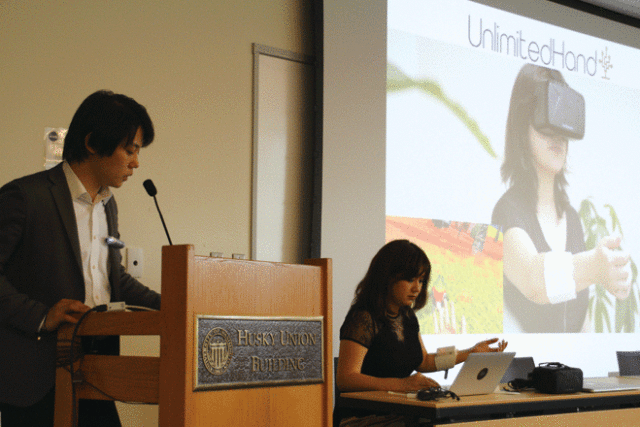
By Maiya Gessling The North American Post
What if you could play the piano or the harp without ever having touched a musical instrument before? What if closing your fist caused a robot across the room to pick something up? These questions only brush the surface of the technology that Dr. Emi Tamaki and Ken Iwasaki of Waseda University are inventing and developing.
Tamaki and Iwasaki are the founders of H2L, Inc., a technology company that is working to research and popularize the use of haptic technology, artificially recreating the sensation of touch, in virtual and augmented reality games. It began in 2010 when Tamaki developed PossessedHand, a device that controls human finger movements via computer and electric stimuli. In September 2015, H2L presented the more sophisticated UnlimitedHand, a game controller that allows the user to touch and feel virtual objects, in San Francisco. The user’s hand could move from the recoil of a gun that only exists on a computer screen or they could feel the weight of a virtual rock.
“Sometimes it sounds like a crazy idea,” said Tamaki at a standingroom only seminar at the University of Washington on Wednesday, hosted by the interdisciplinary Design, Use, Build program, “but this technology is about experiencing other lives in a more immersive way.”
“How many of you are using social media? Snapchat, Facebook, Instagram?” she continued to explain. “If a photo is fun, you push like and share. This indicates that someone’s fun experience is valuable and that you share this value with your friends. With H2L, we want to share your experiences and others’ experiences more deeply. We have ways to share 3-D vision now, and sound, but what about being able to share touch?”
UnlimitedHand uses electrical stimuli, 3-D motion sensors and more familiar technology such as a lithium battery and Bluetooth to create both haptic input and output. When the user moves their hand or fingers, it can cause something to happen in a video game, somewhat similar to Microsoft’s Kinect technology; but it can also give the user the physical feeling of touching an animal, using a weapon or turning a steering wheel when the only thing really there is air.
At the UW, Tamaki shared video of someone with no experience playing Twinkle Twinkle Little Star on a Japanese koto using the PossessedHand device. Tamaki herself demonstrated the UnlimitedHand, her hand jerking as H2L’s co-founder pressed a button that imitated the shooting of a gun.
H2L is using openly available software and hardware protocols for the UnlimitedHand so that it can be easily connected to other devices and used by game and other technology developers.
“We think gaming is just the beginning,” said Iwasaki, “This technology could also be used to install programs that allowed someone to play music, or it could be used to control robots for disabled persons.”
In September, H2L raised almost $75,000 with a Kickstarter project, surpassing their inital goal of $20,000.




